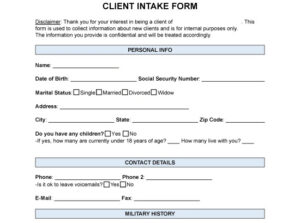Below is a collection of comments gathered from atoun the Internet.

What should a lawyer intake for ask?
If you have a website, you can put your Intake Form online for people to fill out which will save you time and allow you to determine if their case is something that you wish to work on or not.
This intake form should be in junction with a Qualifying form. If someone passes your qualifying form then the next step is to ask them to fill out an intake form.
A lawyer intake form is a tool used by law firms to gather essential information from potential clients during the initial consultation. This form helps lawyers assess the client’s situation, determine whether they can provide legal assistance, and begin forming a case strategy. Here’s a comprehensive list of what a lawyer intake form should typically contain:
- Basic Client Information
– Full Name: The client’s legal name.
– Contact Information: Phone number, email address, and mailing address.
– Date of Birth: Important for identification and age-related legal issues.
– Emergency Contact: Name and contact details of a person to reach in emergencies.
– Preferred Method of Communication: Email, phone, mail, etc.
- Referral Information
– How Did You Hear About Us?: Source of referral (friend, internet search, previous client, etc.)
– Referred By: Specific details if a person or organization referred them.
- Legal Issue Description
– Type of Legal Matter: (e.g., family law, criminal defense, personal injury, corporate law, etc.)
– Brief Description of the Issue: A short narrative of the client’s legal problem.
– Date of Incident: When the legal issue or incident occurred.
– Relevant Parties Involved: Names of other individuals or entities involved in the matter.
- Case-Specific Information
– Details Pertinent to the Case: Depending on the type of case, additional specific questions (e.g., details of the accident for personal injury cases, assets and liabilities for divorce cases, etc.).
– Existing Court Dates or Deadlines: Any upcoming court appearances, hearings, or filing deadlines.
- Legal History
– Previous or Ongoing Legal Matters: Information about any past or current legal cases.
– Representation History: Names of any previous attorneys or law firms involved.
- Financial Information
– Ability to Pay or Insurance Coverage: Details on how the client plans to pay for legal services (self-pay, insurance, payment plan, etc.).
– Income Information: Sometimes required to assess eligibility for certain legal services or fee arrangements.
– Retainer or Consultation Fee Agreement: Confirmation of understanding and agreement to any fees for the initial consultation.
- Conflicts Check Information
– Adverse Parties: Names of any parties the firm should check for conflicts of interest.
- Client Goals and Expectations
– Desired Outcome: What the client hopes to achieve by hiring a lawyer (settlement, acquittal, custody, etc.).
– Expectations from Legal Representation: Understanding of what the client expects from their attorney.
Including these sections in a lawyer intake form helps ensure that the law firm gathers all the relevant information needed to make informed decisions about representing a potential client and provides a foundation for building a strong attorney-client relationship.
ipsum dolor sit amet, consectetur adipiscing elit. Ut elit tellus, luctus nec ullamcorper mattis, pulvinar dapibus leo.
